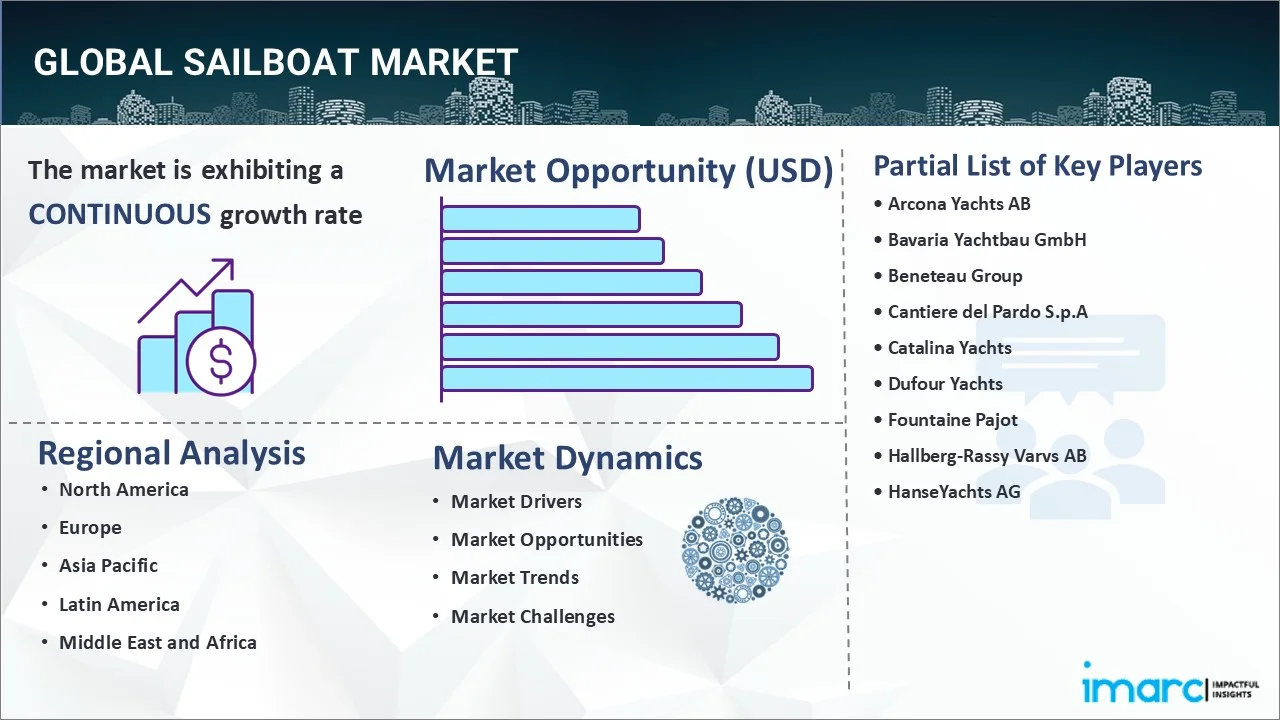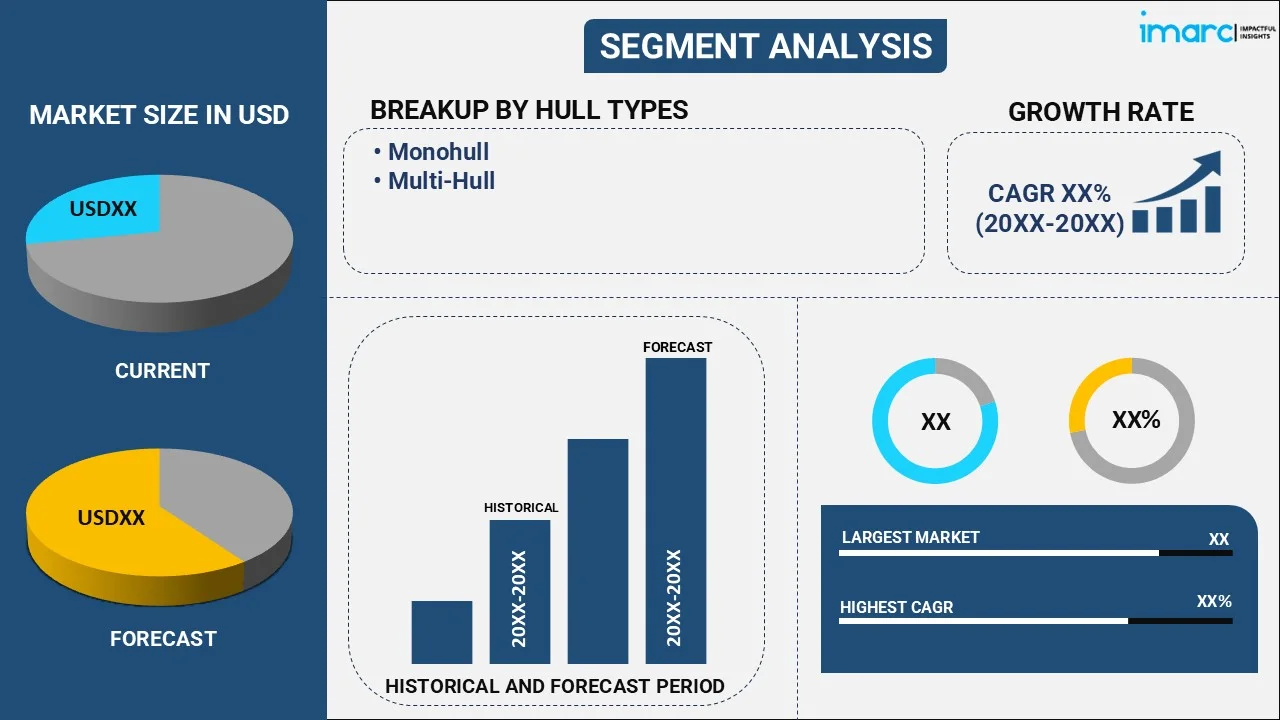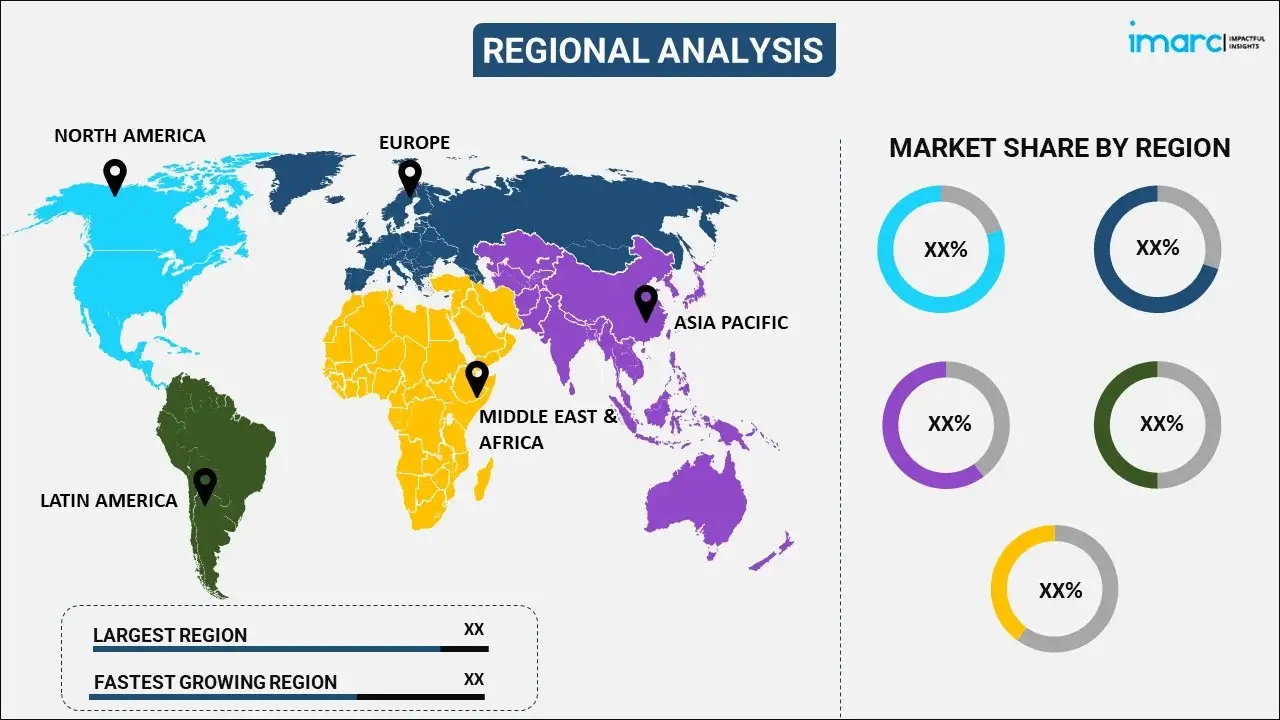
Sailboat Market Report by Hull Type (Monohull, Multi-Hull), Length (Up to 20 Ft, 20-50 Ft, Above 50 Ft), and Region 2025-2033
Market Overview:
The global sailboat market size reached USD 6.4 Billion in 2024. Looking forward, IMARC Group expects the market to reach USD 8.1 Billion by 2033, exhibiting a growth rate (CAGR) of 2.68% during 2025-2033. The rising focus on eco-friendly transportation methods, increase in water-based tourism, favorable government policies, increasing disposable income of the people, rising accessibility of sailboats, growing modernization and customization of sailboats are some of the major factors propelling the market.
|
Report Attribute
|
Key Statistics |
|---|---|
|
Base Year
|
2024 |
|
Forecast Years
|
2025-2033
|
|
Historical Years
|
2019-2024
|
| Market Size in 2024 | USD 6.4 Billion |
| Market Forecast in 2033 | USD 8.1 Billion |
| Market Growth Rate (2025-2033) | 2.68% |
A sailboat is a type of watercraft primarily propelled by sails, offering a mode of maritime travel and recreation. The essential components of a sailboat include a hull, one or more sails, a mast, rigging, and a rudder for navigation. Fiberglass, wood, and metals like aluminum are some of the materials used for the construction of sailboat. They are used for leisurely sailing, competitive racing, educational training and small-scale commercial use. The benefits of using a sailboat include environmental sustainability, as it relies mostly on wind power, thus minimizing fuel consumption and emissions

The increasing modernization in sailboat design is leading to more efficient and easy-to-navigate boats, and this is attracting a broader consumer base which is fostering the demand for the market. Besides this, the rising focus on eco-friendly transportation methods is bolstering the attractiveness of sailboats, which rely primarily on wind power. In line with this, a surge in water-based tourism and recreational sailing is encouraging new investments and innovations in the market. Moreover, economic stability and growing disposable income of consumers enable more people to invest in leisure activities like sailing which is providing an impetus to the market growth. In addition to this, various governments are offering subsidies and tax incentives to promote the sailboat industry, especially those focused on sustainable practices, which is acting as another growth-inducing factor. Other factors, such as the increased accessibility of sailboats and international sailing competitions are supporting the market growth.
Sailboat Market Trends/Drivers:
Surge in water-based tourism
The surge in water-based tourism is indeed a pivotal factor driving the sailboat market. This increase is attributable to multiple elements, such as enhanced consumer spending on leisure activities, evolving tourism landscapes, and a heightened focus on eco-friendly travel options. Moreover, water-based tourism, which includes activities like sailing, cruising, and yachting, often acts as a catalyst for new investments and innovations in the sailboat sector. Destinations known for their natural beauty and marine resources become hotspots for sailing enthusiasts, thereby boosting local economies and increasing demand for sailboats, both for rental and purchase. This demand, in turn, stimulates production, innovation, and market expansion.
Favorable government policies and regulations
Government policies and regulations play a significant role in shaping the trajectory of the sailboat market. Some governments provide financial incentives to stimulate domestic production of sailboats. These may include tax breaks for manufacturers, grants for research and development (R&D), and subsidies to lower production costs. These measures help make sailboats more affordable, thereby boosting both supply and demand. In addition to this, the rising number of certifications and safety standards required by governmental agencies to ensure that only high-quality sailboats enter the market, is favoring the market growth. Besides this, governments regulate the operation of sailboats through licensing requirements. While this ensures a standard level of competence and safety, it also generates awareness and interest in sailing, potentially expanding the customer base.
Increasing Health and Wellness Benefits
The increasing awareness of health and wellness benefits associated with sailing is undeniably a notable factor propelling the sailboat market. As society places more emphasis on mental and physical well-being, sailing is being recognized not just as a leisure activity, but also as a holistic form of health improvement. Sailing involves a variety of physical tasks that engage different muscle groups, such as pulling ropes, steering, and balancing. This full-body workout contributes to enhanced physical health, driving more people to take up sailing as a form of exercise. Moreover, sailing is often a communal activity, fostering stronger interpersonal relationships. The social wellness aspect is appealing to families and groups looking for meaningful ways to spend time together, thereby increasing the demand for sailboats.
Sailboat Industry Segmentation:
IMARC Group provides an analysis of the key trends in each segment of the global sailboat market report, along with forecasts at the global, regional, and country levels for 2025-2033. Our report has categorized the market based on hull type and length.
Breakup by Hull Type:

- Monohull
- Multi-Hull
Monohull dominate the market
The report has provided a detailed breakup and analysis of the market based on the hull type. This includes monohull, and multi-hull. According to the report, monohull represented the largest segment.
The monohull segment continues to be a significant driver in the sailboat market. Monohulls are generally easier to maneuver, particularly in tight spaces like marinas and narrow waterways. Their straightforward design makes them accessible for sailors of various skill levels, broadening their consumer base. In addition to this, monohulls are versatile vessels that are well-suited for a variety of sailing conditions. Whether it is ocean cruising, competitive racing, or leisurely sailing, monohulls can adapt to a wide array of maritime activities. Besides this, monohulls are cost-effective to manufacture, purchase, and maintain compared to multi-hulled sailboats like catamarans or trimarans. Moreover, monohulls are often perceived as more seaworthy in challenging conditions, especially in rough seas and high winds. Their deep keels offer added stability, a feature that is highly valued by long-distance cruisers and those who undertake oceanic voyages.
Breakup by Length:
- Up to 20 Ft
- 20-50 Ft
- Above 50 Ft
Up to 20 Ft hold the largest share in the market
A detailed breakup and analysis of the market based on the length has also been provided in the report. This includes up to 20 ft, 20-50 ft, and above 50 ft. According to the report, up to 20 ft accounted for the largest market share.
Sailboats up to 20 feet in length are currently dominating the sailboat market due to several key factors. Firstly, these smaller sailboats offer affordability, making them accessible to a broader range of consumers. In addition, their compact size allows for easier storage and transportation, appealing to both seasoned sailors and newcomers alike. Moreover, advancements in sailboat design and materials have improved the performance of these smaller vessels. They are now more maneuverable and responsive, offering an enjoyable sailing experience even in smaller bodies of water. Furthermore, the growing interest in day sailing and weekend getaways has driven the demand for smaller sailboats that are perfect for short trips. Finally, environmental consciousness has played a role in the preference for smaller sailboats, as they typically have a lower carbon footprint compared to larger vessels.
Breakup by Region:

- North America
- United States
- Canada
- Europe
- Germany
- France
- United Kingdom
- Italy
- Spain
- Others
- Asia Pacific
- China
- Japan
- India
- South Korea
- Australia
- Indonesia
- Others
- Latin America
- Brazil
- Mexico
- Others
- Middle East and Africa
North America exhibits a clear dominance, accounting for the largest sailboat market share
The market research report has also provided a comprehensive analysis of all the major regional markets, which include North America (the United States and Canada); Europe (Germany, France, the United Kingdom, Italy, Spain, and others); Asia Pacific (China, Japan, India, South Korea, Australia, Indonesia, and others); Latin America (Brazil, Mexico, and others); and the Middle East and Africa. According to the report, North America accounted for the largest market share.
North America is currently dominating the region segment of the sailboat market for several compelling reasons. Firstly, the region boasts an extensive coastline and numerous inland waterways, providing ample opportunities for recreational sailing. This geographical advantage has cultivated a strong sailing culture and a large community of sailing enthusiasts. Additionally, North America has a well-developed infrastructure to support the sailboat industry, including marinas, sailing clubs, and boatyards. This infrastructure facilitates boat ownership and encourages individuals to engage in sailing as a leisure activity. Furthermore, the presence of established sailboat manufacturers and a competitive market has driven innovation and product development, resulting in a wide range of sailboat options catering to various preferences and budgets. Lastly, North America's robust economy has provided consumers with the financial means to invest in sailboats, further fueling the region's dominance in the sailboat market.
Competitive Landscape:
Companies in the sailboat industry are employing various strategies and initiatives to drive growth, innovation, and market expansion. These efforts are aimed at attracting new customers, retaining existing ones, and contributing to the overall development of the industry. Collaborations with sailing schools and training centers create a pipeline of new sailors who are potential customers. These partnerships support skill development and familiarity with sailboats. Besides this, companies participate in sailing events, boat shows, and regattas to showcase their products, build brand visibility, and connect with potential customers. In addition to this, leveraging digital platforms and online marketplaces, companies are reaching a wider audience and simplifying the buying process for customers. Apart from this, key players are focusing on the launch of advanced sailboats with automated systems for sail control, navigation, and even self-steering. These systems use sensors, computers, and actuators to optimize sail trim, adjust course, and maintain stability, which is positively influencing the market growth.
The report has provided a comprehensive analysis of the competitive landscape in the market. Detailed profiles of all major companies have also been provided. Some of the key players in the market include:
- Arcona Yachts AB
- Bavaria Yachtbau GmbH
- Beneteau Group
- Cantiere del Pardo S.p.A
- Catalina Yachts
- Dufour Yachts
- Fountaine Pajot
- Hallberg-Rassy Varvs AB
- HanseYachts AG
Sailboat Market Report Scope:
| Report Features | Details |
|---|---|
| Base Year of the Analysis | 2024 |
| Historical Period | 2019-2024 |
| Forecast Period | 2025-2033 |
| Units | Billion USD |
| Scope of the Report | Exploration of Historical and Forecast Trends, Industry Catalysts and Challenges, Segment-Wise Historical and Predictive Market Assessment:
|
| Hull Types Covered | Monohull, Multi-Hull |
| Lengths Covered | Up to 20 Ft, 20-50 Ft, Above 50 Ft |
| Regions Covered | North America, Europe, Asia Pacific, Latin America, Middle East and Africa |
| Countries Covered | United States, Canada, Germany, France, United Kingdom, Italy, Spain, China, Japan, India, South Korea, Australia, Indonesia, Brazil, Mexico |
| Companies Covered | Arcona Yachts AB, Bavaria Yachtbau GmbH, Beneteau Group, Cantiere del Pardo S.p.A, Catalina Yachts, Dufour Yachts, Fountaine Pajot, Hallberg-Rassy Varvs AB, HanseYachts AG, etc. |
| Customization Scope | 10% Free Customization |
| Post-Sale Analyst Support | 10-12 Weeks |
| Delivery Format | PDF and Excel through Email (We can also provide the editable version of the report in PPT/Word format on special request) |
Key Benefits for Stakeholders:
- IMARC’s industry report offers a comprehensive quantitative analysis of various market segments, historical and current market trends, market forecasts, and dynamics of the sailboat market from 2019-2033.
- The research report provides the latest information on the market drivers, challenges, and opportunities in the global sailboat market.
- The study maps the leading, as well as the fastest-growing, regional markets. It further enables stakeholders to identify the key country-level markets within each region.
- Porter's five forces analysis assist stakeholders in assessing the impact of new entrants, competitive rivalry, supplier power, buyer power, and the threat of substitution. It helps stakeholders to analyze the level of competition within the sailboat industry and its attractiveness.
- Competitive landscape allows stakeholders to understand their competitive environment and provides an insight into the current positions of key players in the market.
Key Questions Answered in This Report
The sailboat market was valued at USD 6.4 Billion in 2024.
The sailboat market is projected to exhibit a CAGR of 2.68% during 2025-2033, reaching a value of USD 8.1 Billion by 2033.
Key growth drivers include rising eco-consciousness in transport, growth in water-based tourism, government incentives for sustainable boating, increasing disposable income, better accessibility, and ongoing innovation in sailboat design and customization.
North America currently dominates the sailboat market, accounting for the largest share due to its vast coastline, sailing infrastructure, strong economic conditions, and an active community of sailing enthusiasts.
Some of the major players in the sailboat market include Arcona Yachts AB, Bavaria Yachtbau GmbH, Beneteau Group, Cantiere del Pardo S.p.A, Catalina Yachts, Dufour Yachts, Fountaine Pajot, Hallberg-Rassy Varvs AB, HanseYachts AG, etc.
Need more help?
- Speak to our experienced analysts for insights on the current market scenarios.
- Include additional segments and countries to customize the report as per your requirement.
- Gain an unparalleled competitive advantage in your domain by understanding how to utilize the report and positively impacting your operations and revenue.
- For further assistance, please connect with our analysts.
 Request Customization
Request Customization
 Speak to an Analyst
Speak to an Analyst
 Request Brochure
Request Brochure
 Inquire Before Buying
Inquire Before Buying




.webp)




.webp)












